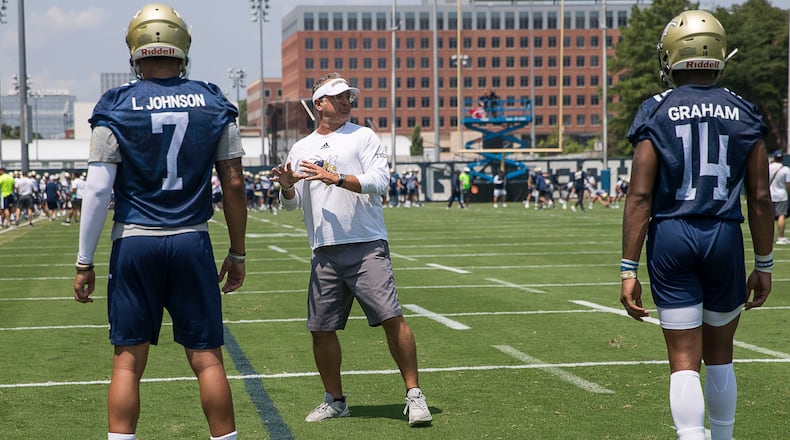I expected Dave Patenaude to say everyone is making too much of Georgia Tech’s transition to a new era of offensive football. Sure, the Yellow Jackets are leaving behind Paul Johnson’s famed “Flexbone” triple-option offense for Patenaude’s modernized spread. But football is football, so surely the change isn’t as drastic as it might seem from the outside.
Right?
“Well, it is true,” Patenaude said Tuesday on The Flats. “We are making a big jump.”
The offensive fundamentals are the same at Tech as everywhere else. Said Patenaude: “You have to run, block, catch and throw.” But Tech has more questions about those last two things than any program in America.
Tech quarterbacks who’ve spent nearly all their time running and pitching now will drop back and pass. Wide receivers known for blocking on perimeter runs will run more routes than ever. Running backs who rarely worried about pass protection now must recognize and pick up blitzes. Offensive linemen accustomed to firing low off the ball for cut blocks had to be schooled in the basics of pad level and footwork.
The Jackets will look to push the tempo after 11 seasons of dominating time of possession. The beauty of the triple-option was that the Jackets were very good at doing one thing well. That forced opponents to keep it simple, too, because soundness with assignments was more important than exotic looks. Now the Jackets will see varying defenses.
“Biggest thing coming out of a triple-option offense, you are just not used to all of the multiple things that you are going to get and all the things you have to understand,” Patenaude said.
Teams that switch coaches always have a transition. But this isn’t like changing from one version of a spread offense to another. When that happens, players eventually figure out the new coach is doing many of the same things as the old one with slight variations in design and terminology.
“There is none of that now,” Patenaude said. “It’s like, ‘We’ve never seen that before.’”
There’s not much recent precedence for what Tech is doing. Programs that run the triple-option now have been doing it for a long time. When an option coach leaves, another is hired. The transition from old-fashioned option offenses to something new happened so long ago that what was new then since has been supplanted by something else.
That means there is no recent blueprint for Patenaude to follow. There are not many coaches he could call to ask about a smooth transition from the triple-option to something different.
“There was something that came up, like way back coach Spurrier was somehow involved,” Patenaude said. “I was like, ‘Wow, that’s pretty good company to be in.”
Steve Spurrier revolutionized the SEC when he brought his “Fun ’n Gun” offense to Florida in 1990. Spurrier’s predecessor, Galen Hall, had great success with the Wishbone as Oklahoma’s offensive coordinator the 1970s under Barry Switzer. But Hall’s Florida teams passed about 40 percent of the time even when Emmitt Smith was the tailback.
Pat Dye ran the Wishbone early in his tenure at Auburn with Bo Jackson as the star back. Eventually Dye switched to an I-formation and passed the ball more often. During the 1992 season, Dye’s last as coach, Auburn’s run/pass split was 59 percent to 41 percent.
Bill McCartney had his offensive coordinator, Gerry DiNardo, adopt an I-formation version of the triple option as Colorado coach in the mid-1980s. The Buffaloes started winning more games and eventually became co-national champions in 1990. But McCartney’s team started passing a lot in 1992, which is what you do when Kordell Stewart is the quarterback.
The most recent and relevant model for Tech may be Vanderbilt’s transition from DiNardo to Ron Dowhower in 1995. DiNardo used his version of the triple option to win 18 games in four years, after Vandy had won nine over the previous four. The Commodores went from passing on about 23 percent of plays under DiNardo to 40 percent with Dowhower, who was fired after two 2-9 seasons.
Tech’s transition will be even more drastic. Johnson was running the triple-option until the day he retired. The switch to Patenaude’s offense is a true shock to the Jackets’ system.
“In the spring that was an issue,” Patenaude said. “Guys were still wanting to line up in a four-point stance and just cut people, run the ball on the edge. Our understanding of what we are doing is so far past that now that I don’t keep falling back on that.”
Tech offensive tackle Zach Quinney said pass blocking is easier now because linemen don’t have to transition from weight forward over two hands on the ground. Wide receiver Adonicas Sanders said his group feels disrespected by the questions about the passing game and vowed it would “prove a lot of people wrong this year.”
Patenaude said his staff is still “grinding” to find one quarterback who can do it all. The apparent front-runner to start, Lucas Johnson, set passing records at Mount Carmel High School in San Diego. He hasn’t attempted a pass in three seasons at Tech.
“When you watch us practice right now, you would never know we were an option team just six months ago,” Patenaude said. “We look like a fast-paced, spread team that can move the ball and throw it pretty efficiently.”
It would be truly revolutionary for the Jackets do that against opponents this season after they did it Johnson’s way for so long.
About the Author
The Latest
Featured


